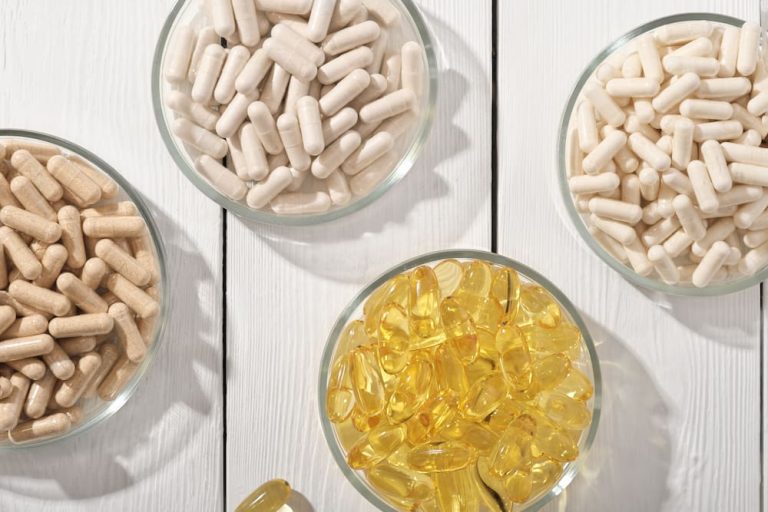Glutathione — the body’s so-called ‘master antioxidant’ — is a critical component of the body’s antioxidant defense mechanism, in addition to supporting the vital health functions of the heart, liver, kidneys, nervous system, skin, and hair.
The body’s antioxidant defense mechanism becomes overwhelmed when there is a build-up of free radicals — highly reactive and unstable molecules — resulting in oxidative stress. Oxidative stress is one of the underlying causes of several age-related adverse health conditions.
The level of glutathione in the body decreases with the natural aging process because of a marked reduction in its production. . Dietary supplementation with glutathione can help restore this powder antioxidant, helping to maintain optimal levels to limit oxidative stress, which, in turn, promotes healthy aging.
What improves the effectiveness of an oral glutathione supplement, and what should you look for when considering a glutathione supplement formulation? Get answers below regarding glutathione supplements and why you should consider a particular advanced glutathione formulation. Use the links below to jump ahead to different topics on the page.
How Does Glutathione Work at the Cellular Level?

Before looking for the most effective glutathione supplement, let’s first understand how glutathione works at the cellular level. Chemically, glutathione is made of three different amino acids — glycine, cysteine, and glutamic acid — and is present in nearly every cell in the body. It exists in our cells in two forms — reduced (GSH) and oxidized (GSSG) — with the reduced form being predominant.
The following table summarizes why glutathione is often referred to as the body’s master antioxidant.1
| Glutathione — The ‘Master Antioxidant’ | ||
|---|---|---|
| Antioxidant defense | Glutathione is the most important redox regulator — it helps maintain a balance between oxidation reactions and reduction reactions in the cells.*Glutathione neutralizes free radicals, thereby helping to maintain normal inflammatory responses.*Glutathione further eliminates the free radicals produced by the liver’s phase I detoxification of chemical toxins. It also plays a key role in transporting heavy metals, such as mercury, out of cells and can support the brain’s clearance of these metals1. | |
| Regulating cellular functions | Glutathione promotes the healthy regulation of cellular growth and programmed cell death.It is vital to normal mitochondrial function and optimal maintenance of mitochondrial DNA. | |
| Regenerating vitamins C and E | Glutathione recycles vitamins C and E, both powerful antioxidants, which further protect cells from free radicals.*It is a cofactor for several antioxidant enzymes, forming an integrated antioxidant defense system2. | |
| Nutrient metabolism | Glutathione plays a role in regulating glucose, lipid, and amino acid metabolism in the body3. | |
Glutathione Supplementation to Promote Health Functions
Glutathione’s pivotal role in enhancing metabolic detoxification, limiting oxidative stress, and maintaining redox balance establishes its level in the body as an important biomarker for determining healthy aging and health conditions related to aging.
Let’s look at how glutathione supplementation supports various health functions in the body.
| How Does Glutathione Supplementation Support Health Functions? | ||
|---|---|---|
| Nervous System | Glutathione depletion in the brain is associated with several neurodegenerative conditions4.Glutathione is involved in several pivotal functions in the central nervous system, including cellular differentiation, cell growth, cell death, enzyme activation, and neurotransmission.*6 | |
| Gastrointestinal System | Glutathione is abundantly distributed in the gastrointestinal tract. Glutathione’s detoxifying and antioxidant properties limits oxidative stress and damage to the cells lining the gastrointestinal tract.*7 | |
| Endocrine System | Glutathione is highly valued for its beneficial function in liver detoxification.*Glutathione is a co-factor with several enzymes that regulate the liver’s complex detoxification pathways, helping to:Excrete heavy metals, such as mercury, from cells.*Neutralize and excrete persistent organic pollutants and other oxidative chemicals.*Excrete drug metabolites.* Glutathione depletion is associated with a decrease in the levels of several thyroid hormones.8Glutathione-S-transferase, an important detoxification enzyme, plays a beneficial role in regulating the action and metabolism of thyroid hormones.s9 |
|
| Skin and Hair | Glutathione has been extensively studied for its antioxidative benefits in limiting skin damage.*10Glutathione may benefit hair growth and pigment retention. *11 | |
Glutathione’s Absorption Challenges
Eating foods rich in sulfur-containing amino acids, such as cysteine and methionine, which are the precursors to glutathione synthesis, can increase the level of glutathione in your body. The natural production of glutathione can be boosted by eating eggs, poultry, lean meats, nuts, seeds, and legumes. While dietary glutathione may contribute to local antioxidant effects in the gut, its impact on systemic glutathione levels is limited due to poor absorption. .
The following table highlights some of the factors affecting glutathione absorption when consumed orally.
| Glutathione’s Absorption Challenges | ||
|---|---|---|
| Rapid metabolism | Most oral glutathione is absorbed in the small intestine, where the activity of intestinal enzymes results in its rapid metabolism and recycling of GSH precursors, which limits glutathione’s intact absorption12.* | |
| Excretion of circulating glutathione | Extracellular glutathione conjugates formed in the liver are summarily excreted through the bile or the urine. | |
Looking for the Most Effective Glutathione Supplement
Commercial glutathione supplements typically contain between 150 mg and 1,000 mg of glutathione. The question is whether a higher dose actually translates to greater effectiveness.
Glutathione has naturally poor absorption, which limits its impact as a nutritional supplement. As a result, even when consumed in large amounts through food or supplements, it often produces only a modest increase in glutathione levels in the blood and within cells.
So, what makes a formulation the most effective glutathione supplement? The following are several factors to consider:
- Active nutrient: In contrast to unformulated glutathione, S-acetyl-glutathione, as the active nutrient in a formulation, is considered superior because it is more stable in plasma, better absorbed, and more efficiently increases intracellular glutathione levels13.*
- Nutrient delivery: An effective glutathione supplement should enhance its absorption and optimize its bioavailability. Formulations that utilize nutrient delivery methods, such as the encapsulation of the glutathione in liposome or nanoparticle formats, are more effective than unformulated glutathione14.*
- Enhanced absorption: Formulations that contain additional synergistic ingredients, such as vitamin C, help with maintenance and regeneration of glutathione within cells15*.
Types of Glutathione Supplements

Glutathione is widely considered to be well-tolerated with no significant adverse side effects. This important ‘master antioxidant’ is commercially available as:
- Oral supplements
- Intravenous (IV) drips
- Intranasal drops or spray
- Nebulized glutathione
So, which of these supplement formulations is the most effective? The following table highlights the benefits and drawbacks of the different types of glutathione supplements:
| Types of Glutathione Supplements | |
|---|---|
| Oral Supplement | Advantage: Most popular, easy to use, cost-effective Drawback: Rapid metabolism in the intestine, limiting intact absorption. |
| Intravenous drip (IV) | Advantage: Bypasses glutathione dilution in the gastrointestinal tract, which slows glutathione metabolism, resulting in increased absorption. Drawback: Expensive and requires medical supervision. |
| Intranasal drops/sprays | Advantage: Bypasses the blood-brain barrier, which slows glutathione’s degradation. Drawback: Nasal congestion adversely affects the efficacy of intranasal glutathione drops/sprays. |
| Nebulized glutathione | Advantage: A supplementary therapy to address certain respiratory conditions. Drawback: Only limited data is available on the efficacy of this delivery method. |
Choosing the Most Effective Glutathione Supplement
Although the oral administration of glutathione is not the most effective delivery method, it is highly preferred because of its ease of use. As a result, most research on glutathione’s bioavailability and absorption has been conducted on oral supplements. When discussing the features of the most effective glutathione supplement in this section, we are describing oral glutathione supplements, such as glutathione in powder, tablet, and capsule formats.
The following table highlights several factors you should consider when choosing an oral glutathione supplement:
Choosing A Glutathione Supplement: Factors to Consider |
||
|---|---|---|
| Factor | Description | |
| Resistance to breakdown | S-acetyl-glutathione is the most effective form of oral glutathione because of its increased stability and resistance to breakdown in the intestinal tract16.* | |
| Phytonutrients | Nutritional interventions, including phytochemicals, antioxidants, minerals, and other phytonutrients, enhance the circulating level of glutathione17.* | |
| Novel formulations | Novel supplement formulations, including nanoformulations, enhance glutathione’s absorption in the body18.* | |
Including An Advanced Glutathione Supplement in Your Healthcare Routine/Plan
The enhanced bioavailability and absorption of glutathione are the two critical indicators of a supplement formulation’s efficacy. An advanced glutathione supplement will enhance the solubility and absorption of glutathione, even when delivered in microdoses.
SafeCell® is an innovative, hypoallergenic S-Acetyl-Glutathione complex developed by Tesseract Medical Research. Tesseract’s proprietary CyLoc® – DexKey® nutrient delivery nanotechnology optimizes glutathione’s absorption and bioavailability. The CyLoc® technology encases each glutathione molecule, protecting it from early degradation during transit through the stomach. The accompanying DexKey® reactors enable targeted delivery of the active ingredient molecules to achieve enhanced absorption.
The result is unprecedented absorption of glutathione in lesser amounts than previously required (microdosing) to promote healthy aging.*
The power of Tesseract supplements lies in enhancing palatability, maximizing solubility, absorption, and bioavailability, and micro-dosing multiple nutrients in a single, highly effective capsule. Shop products on our website and learn more about how they support your healthy aging.*
References:
1Vázquez-Meza H, et al. Antioxidants (Basel). 2023;12(4):834. Published 2023 Mar 29. doi:10.3390/antiox12040834
2Averill-Bates DA. The antioxidant glutathione. Vitam Horm. 2023;121:109-141. doi:10.1016/bs.vh.2022.09.002
3Wu G, et al. J Nutr. 2004;134(3):489-492. doi:10.1093/jn/134.3.489
4Iskusnykh IY, et al. Molecules. 2022;27(1):324. Published 2022 Jan 5. doi:10.3390/molecules27010324
5Averill-Bates DA. Vitamins and Hormones vol. 121 (2023):109-141. doi:10.1016/bs.vh.2022.09.002
6Iskusnykh IY, et al. Molecules (Basel, Switzerland) vol. 27,1 324. 5 Jan. 2022, doi:10.3390/molecules27010324
7Loguercio C, Di Pierro M. Italian Journal of Gastroenterology and Hepatology vol. 31,5 (1999):401-407.
8Reddy VS, et al. Horm Metab Res. 2013;45(10):754-758. doi:10.1055/s-0033-1348262
9Ishigaki S, et al. Archives of Biochemistry and Bbiophysics vol. 273,2 (1989):265-272. doi:10.1016/0003-9861(89)90483-9
10Cui X, et al. J Eur Acad Dermatol Venereol 2024;38 Suppl 3:12-20. doi:10.1111/jdv.19718
11Galván I, et al. Physiological and Biochemical Zoology: PBZ vol. 85,4 (2012):332-347. doi:10.1086/666606
12Gould RL, et al. Impact of Supplementary Amino Acids, Micronutrients, and Overall Diet on Glutathione Homeostasis. Nutrients. 2019;11(5):1056. Published 2019 May 11. doi:10.3390/nu11051056
13Camillerapp C, et al. Food Chem Toxicol. 2025;199:115279. doi:10.1016/j.fct.2025.115279
14,18Byeon JC, et al. Drug Deliv. 2019;26(1):216-225. doi:10.1080/10717544.2018.1551441
15Shang F, et al. Free Radic Biol Med. 2003;34(5):521-530. doi:10.1016/s0891-5849(02)01304-7
16Yin N, et al. Pharmaceutics. 2025;17(3):385. Published 2025 Mar 18. doi:10.3390/pharmaceutics17030385
17Minich DM, et al. Nutrients. 2019;11(9):2073. Published 2019 Sep 3. doi:10.3390/nu11092073


